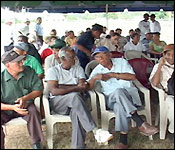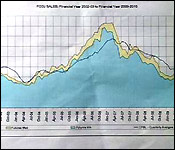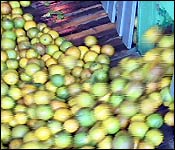 On Wednesday we took you down south for an emergency meeting of the Citrus Growers Association. The Growers said basically that they weren't getting the benefit of premium world citrus prices for their product because of either bad management, or bad mindedness at Citrus Products of Belize Limited. In fact, influential grower Eugene Zabaneh went as far as calling it "criminal".
On Wednesday we took you down south for an emergency meeting of the Citrus Growers Association. The Growers said basically that they weren't getting the benefit of premium world citrus prices for their product because of either bad management, or bad mindedness at Citrus Products of Belize Limited. In fact, influential grower Eugene Zabaneh went as far as calling it "criminal".
The CGA says their members are suffering because Citrus products of Belize undersold their product on the world market. Today we spoke with the CEO of Citrus products Henry Canton who said it's not true and the growers association should know better.
For context we begin with one of the allegations leveled against him by Eugene Zabaneh:.
June 30, 2010
 Eugene Zabaneh, Grower
Eugene Zabaneh, Grower
"From what was put there, under $1.10, 63%. Over $1.10, 80%. That clearly shows who this product belongs to. This gentleman is selling our product, he is selling our product. There is a fiduciary duty that clings around his neck and if he departs so drastically away from what the market is saying. His duty is to come back to the owner of this product - which is us - it's very clear to say, listen, we have a problem here and this is the problem and I have to sell now for whatever it is."
Henry Canton, CEO - CPBL
"I think Mr. Zabaneh needs to review the price formula because, yes, his statement that up to $1.10 the CGA share 63% on the net revenue is true, but the misrepresentation is that above $1.10 it is not the whole. Let's say if it goes to $1.15, it's not the whole $1.15 that becomes 80% it's only the difference above $1.10 which is 5 cents that the growers share 80% in, which is a substantial difference than what he is saying. So I don't know if Mr. Zabaneh does not know the price formula or he is just intentionally trying to misrepresent the formula and it is inflammatory how else can you interpret that. How do you interpret, it Jules? I mean you been in this thing long enough, you've been with the argument back and forth over the year and a half to two years and you've seen this thing develop and I can only ask you the same question back."
 "I think that it is the associations' job to go and say that you must get me a better price and they have to hold us to the fire. They have to make sure that in fact we are doing what we are supposed to be doing. But as I said if one was to look at the actual record, look at the black and white, look at the paper work, you will see that the evidence is there. It's just that I think the new spin of the association is let's take it to the court of public opinion. And where Jules Vasquez 5 years ago would think twice about jumping on a plane and coming down to Stann Creek to do CGA meeting. They just say, Jules! and he's on the next plane because he knows that he is going to have some really nice juicy stuff to put on the TV that night, That is just a new era, communications is different, internet is different, it's all a new different concept."
"I think that it is the associations' job to go and say that you must get me a better price and they have to hold us to the fire. They have to make sure that in fact we are doing what we are supposed to be doing. But as I said if one was to look at the actual record, look at the black and white, look at the paper work, you will see that the evidence is there. It's just that I think the new spin of the association is let's take it to the court of public opinion. And where Jules Vasquez 5 years ago would think twice about jumping on a plane and coming down to Stann Creek to do CGA meeting. They just say, Jules! and he's on the next plane because he knows that he is going to have some really nice juicy stuff to put on the TV that night, That is just a new era, communications is different, internet is different, it's all a new different concept."
The record that Canton refers to is in some part dense commodity charts like these that you'd probably need a master's degree in finance to decode. It shows the rise and fall in orange juice commodity price between 2009 and 2010.
This chart shows the difference in price between what are known as citrus futures that the yellow peak at the top and what citrus products of Belize actually earned, which is blue line beneath.


Kent Herrera, Chief Financial Officer - CPBL
"I think sometimes they find it very convenient to take the snapshot and say, ok, the price is at $1.40 - the price is never always at that. We have had 8 price formula submissions for them: 3 for grapefruit and 5 for orange. In each one of those submissions we have sat down with CGA and have at least 3 -4 hours discussion explaining these very variables and what we were dealing the stocks that we had brought forward, where we had not yet contracted, and where we had a opportunity for rises in the market; we discussed the new production; we discussed the yields problem, we discussed the market expectations."
The difference between what's being paid for futures and what CPBL actually gets those is what's really at the heart of this dispute. But Canton and his financial officer say that over the course of a year it evens out on a volatile commodities market.
Kent Herrera
"I think that the area that CGA many times has an issue on, though, is on the issue on the market at a particular snapshot point. Whenever they have the discussion I think they are really keep focusing only on what the market is at that point. I think then they make a fruit price translation base on that snapshot approach. When you do that you obviously get a whole different number. When you take it in a structured way, the way the formula is structured the formula really states that whatever you have from last year in terms of products which we have not yet sold, you have to bring in to this year, whatever you produce this year you need to be taken account of, and that whole contraction is consummated over a period of a year."
Henry Canton
"If I were to strictly look at it as a grower and I would look at futures I would say to myself you know, jeez, I should get more, yes I should get more. However if I were to take the period of production from when I started buying or started selling my fruit to when I finish selling my fruit and was to truly look at the futures chart and draw a line of average what I would see today on 2009-2010 average is I would see an average of about $1.15. I would say to you that if I sat down with my board and presented that to them that they will have difficulty arguing with me that we have not done a good job and, in fact, it's only today because of the characters that are now in play that we are at the point we are at."
Canton says that if they had gotten more citrus delivered, then the price formula would have been different
Henry Canton
"We have a plant that can take 10 million boxes and this year we did 5.2 million, so we are operating at 52% efficiency. We are not going to survive, so it would be foolish of me to not pay the growers what is due them for them to not be able to produce the raw material that needs to go into the plant. If not, I am going to end up with a facility that yes it might be beautiful and state of the art but at the end of the day it's a white elephant."
Kent Herrera
 "Last year we produced around 5.6 - 5.7 million boxes. This year we got 3.85 million boxes, so it dropped tremendously, about 34%. Had we had those additional production and those additional volumes we would been looking at additional boxes of fruit which would have translated around 12 million pound solids. That 12 million pound solid would have been additional volumes that would have been sold now at market prices. This price now we are looking at is $1.40 - $1.50. So had we had that additional amount, the price this year would have been much higher."
"Last year we produced around 5.6 - 5.7 million boxes. This year we got 3.85 million boxes, so it dropped tremendously, about 34%. Had we had those additional production and those additional volumes we would been looking at additional boxes of fruit which would have translated around 12 million pound solids. That 12 million pound solid would have been additional volumes that would have been sold now at market prices. This price now we are looking at is $1.40 - $1.50. So had we had that additional amount, the price this year would have been much higher."
And while this surely isn't the end of this argument – Canton says all sides should be cautious:
Henry Canton
"I caution the CGA. The growers are not foolish people. You can only play them for a little while and we need to be careful that in playing them that we don't play them to where it turns negative on all of us."
Herrera says that the sales contract which the CGA claims is suspect has been made available for review by the CGA's accountant.
The backdrop for all this bickering is that CPBL's board of directors – meaning the CGA representatives and the Banks Holdings representatives are reported to have met in Miami today.



